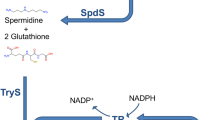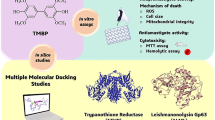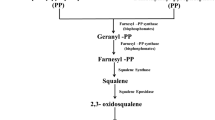Abstract
Trypanothione reductase (TryR) is a validated drug target against Leishmaniasis. Using integrated computational and experimental approaches, the authors report doxorubicin and mitomycin C, known antitumor agents, as novel inhibitors of TryR of leishmania parasite. Interestingly, these compounds also act as subversive substrates and subvert the physiological function of enzyme by converting it from an anti-oxidant to a pro-oxidant. Possible mechanism of subversive substrate is discussed. Both doxorubicin and mitomycin C show significant effect on redox homeostasis of the parasite and high-leishmanicidal activity. The toxicity studies as well as available toxicity data in literature indicate these compounds to have acceptable toxicity in limited dose.








Similar content being viewed by others
References
Myler P, Fasel N (2008) Leishmania: after the genome. Caister Academic, Norfolk
Desjeux P (1992) Human leishmaniases, epidemiology and public health aspects. World Health Stat 45:267–275
Tempone AG, Borboremab SE, de Andrade HF, Amorim Gualda NC, Yogi A, Carvalho CS, Bachiega D, Lupo FN, Bonottoc SV, Fischer DC (2005) Antiprotozoal activity of Brazilian plant extracts from isoquinoline alkaloid-producing families. Phytomedicine 12:382–390
Shukla AK, Singh BK, Patra S, Dubey VK (2010) Rational approaches for drug designing against leishmaniasis. Appl Biochem Biotechnol 160:2208–2218
Fairlamb AH, Cerami A (1992) Metabolism and functions of trypanothione in the Kinetoplastida. Annu Rev Microbiol 46:695–729
Krauth-Siegel RL, Comini MA (2008) Redox control in trypanosomatids, parasitic protozoa with trypanothione-based thiol metabolism. Biochim Biophys Acta 1780:1236–1248
Henderson GB, Fairlamb AH, Ulrich P, Cerami A (1987) Substrate specificity of the flavoprotein trypanothione disulfide reductase from Crithidia fasciculate. Biochemistry 26:3023–3027
Singh BK, Sarkar N, Jagannadham MV, Dubey VK (2008) Modeled structure of trypanothione reductase of Leismania infantum. BMB Reports 41:444–447
Kole L, Das L, Das PK (1999) Synergistic effect of interferon-g and mannosylated liposome-incorporated doxorubicin in the therapy of experimental visceral leishmaniasis. J Infect Dis 180:811–820
Sett R, Basu N, Ghosh A, Das PK (1992) Potential of doxorubicin as an antileishmanial agent. J Parasitol 78:350–354
Singh G, Dey CS (2007) Induction of apoptosis-like cell death by pentamidine and doxorubicin through differential inhibition of topoisomerase II in arsenite-resistant L. donovani. Acta Trop 103:172–185
Mukherjee S, Das L, Kole L, Karmakar S, Datta N, Das PK (2004) Targeting of parasite-specific immunoliposome-encapsulated doxorubicin in the treatment of experimental visceral leishmaniasis. J Infect Dis 189:1024–1034
Sereno D, Lemesre JL (1997) Axenically cultured amastigote forms as an in vitro model for investigation of antileishmanial agents. Antimicrob Agents Chemother 41:972–976
Morris GM, Goodsell DS, Halliday RS, Huey R, Hart WE, Belew RK, Olson AJ (1998) Automated docking using a Lamarckian genetic algorithm and an empirical binding free energy function. J Comput Chem 19:1639–1662
Huey R, Morris GM, Olson AJ, Goodsell DS (2007) A semiempirical free energy force field with charge-based desolvation. J Comput Chem 28:1145–1152
Santhosh KV, Shukla AK, Dubey VK (2010) Molecular docking studies of selected tricyclic and quinone derivatives on trypanothione reductase of Leishmania infantum. J Comput Chem 31:2463–2472
Wallace AC, Laskowski RA, Thornton JM (1995) LIGPLOT, A program to generate schematic diagrams of protein-ligand interactions. Prot Eng 8:127–134
Baicco P, Franceschini S, Ilari A, Colloti G (2009) trypanothione reductase from Leishmania infantum: cloning, expression, purification, crystallization and lreliminary X-ray data. Protein Pept Lett 16(2):196–200
Hamilton CJ, Saravanamuthu A, Eggleston IM, Fairlamb AH (2003) Ellman’s-reagent-mediated regeneration of trypanothione in situ, substrateeconomical microplate and time-dependent inhibition assays for trypanothione reductase. Biochemistry 369:529–537
Mosmann T (1983) Rapid colorimetric assay for cellular growth and survival, application to proliferation and cytotoxicity assays. J Immunol Method 65:55–63
Balasubramanyam M, Koteswari AA, Kumar RS, Monickaraj SF, Maheswari JU, Mohan V (2003) Curcumin-induced inhibition of cellular reactive oxygen species generation. J Biosci 28:715–721
Kazi YF, Parton R, Memon BA (1994) Haemolytic assay for the detection of adenylate cuclase toxin for Bordetella pertueeis. Pakistan J Pharma Sci 7:55–59
Murthy ASN, Balasubramanian A, Rao CNR, Kasturi TR (1962) Spectroscopic studies of keto-enol equilibria. Can J Chem 10:2267–2271
Colucci MA, Moody CJ, Couch GD (2008) Natural and synthetic quinones and their reduction by the quinone reductase enzyme NQO1, from synthetic organic chemistry to compounds with anticancer potential. Org Biomol Chem 5:3665–3673
Tardi PG, Boman NL, Cullis PR (1996) Liposomal doxorubicin. J Drug Targe 4:129–140
Dirix LY, Libura M, Libura J, Vermeulen PB, Bruijn D, Ernst A, Van O, Allan T (1997) In vitro toxicity studies with mitomycins and bleomycin on endothelial cells. Anti-Cancer Drugs 8:859–868
Singh BK, Dubey VK (2009) In silico studies on tryparedoxin peroxidase of Leishmania infantum: structural aspects. Curr Pharm Biotechnol 10:626–630
Saravanan P, Venkatesan SK, Mohan CG, Patra S, Dubey VK (2010) Mitogen-activated protein kinase 4 of Leishmania parasite as a therapeutic target. Eur J Med Chem 2010(45):5662–5670
Acknowledgments
Research fellowship to AKS by Indian Institute of Technology Guwahati is acknowledged. Financial support by Department of Biotechnology Government of India in the form of research grant (Project nos: BT/01/IYBA/2009 and BT/PR10966/MED/29/88/2008) to VKD is also acknowledged. Authors are thankful to Dr. Andrea Ilari and Dr.Gianni Colotti, Università “La Sapienza” Rome, Italy for providing clone of TryR and Dr. A. Sahasrabuddhe, CDRI Lucknow for providing us Leishmania culture for the work. Authors acknowledge help of Mr. Santhosh K. Venkatesan, IITG in docking studies.
Author information
Authors and Affiliations
Corresponding author
Electronic supplementary material
Below is the link to the electronic supplementary material.
Rights and permissions
About this article
Cite this article
Shukla, A.K., Patra, S. & Dubey, V.K. Evaluation of selected antitumor agents as subversive substrate and potential inhibitor of trypanothione reductase: an alternative approach for chemotherapy of Leishmaniasis. Mol Cell Biochem 352, 261–270 (2011). https://doi.org/10.1007/s11010-011-0762-0
Received:
Accepted:
Published:
Issue Date:
DOI: https://doi.org/10.1007/s11010-011-0762-0




